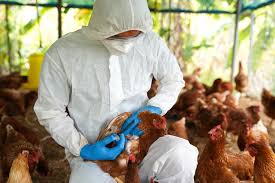avian flu treatment in birds

What is Avian Flu?
Avian flu treatment in birds aims to manage symptoms and prevent spread. This viral infection affects wild and domestic birds. Symptoms include respiratory issues, reduced egg production, and, in severe cases, sudden death. The virus has two types: low pathogenic avian influenza (LPAI) causes mild illness, while high pathogenic avian influenza (HPAI) is more deadly. Treatment options are limited, especially for HPAI. Preventive steps like quarantine, biosecurity, and sometimes vaccination are key to controlling outbreaks.
The primary difference in treatment approaches between Low Pathogenic Avian Influenza (LPAI) and Highly Pathogenic Avian Influenza (HPAI) lies in the severity and containment strategies:
LPAI (Low Pathogenic Avian Influenza): Treatment for LPAI is more feasible, as the virus typically causes mild symptoms in poultry. Supportive care can be provided, such as maintaining clean environments, managing stress, and monitoring nutrition to help birds recover. Vaccines may also be used in some areas to protect flocks from certain LPAI strains.
HPAI (Highly Pathogenic Avian Influenza): For HPAI, treatment is rarely attempted due to the rapid progression, high mortality, and high contagiousness of the virus. Instead, the approach is often culling infected and exposed birds to prevent spread. As it’s considered the most effective way to contain outbreaks. Supportive care is not typically effective in controlling HPAI due to the virus’s aggressive nature. The risks it poses to other birds and potentially to human health
Why is it a Concern?
Avian flu is a significant concern because certain strains of the virus can jump from birds to humans, posing serious health risks. While most bird flu viruses do not infect humans. Some particularly the H5, H7, and H9 subtypes, have the potential to cross the species barrier. When this occurs, the virus can cause severe respiratory illness, and, in rare cases, death.
How Avian Flu Spreads to Humans
Human infection typically occurs through direct or close contact with infected birds. Including handling poultry, inhaling contaminated particles, or being exposed to surfaces contaminated with the virus. Wild migratory birds often carry avian flu viruses without symptoms. It can spread them to poultry populations. Creating a risk for humans who come into contact with infected flocks.
Health Risks for Humans
Once transmitted to humans, avian flu viruses can lead to severe respiratory illnesses like pneumonia and acute respiratory distress syndrome (ARDS). The symptoms of avian flu in humans are generally more intense than those of seasonal flu and can include fever, cough, sore throat, and muscle pain, often progressing rapidly. Some strains of avian flu, such as H5N1 and H7N9, have been associated with high mortality rates in humans. Although these infections are relatively rare.
Economic and Agricultural Impacts
Beyond health risks, avian flu outbreaks can severely impact poultry industries. They leading to significant economic losses due to culling of infected flocks and restrictions on poultry trade. This in turn, can impact food security and livelihoods for those dependent on poultry farming.
Causes of Avian Flu in Birds
Bird flu, or avian influenza, in birds is primarily caused by influenza Type A viruses, which naturally occur among wild aquatic birds and can infect domestic poultry and other bird species.
Here are the primary causes and contributing factors that lead to bird flu infections in birds:
Virus Spread from Wild Birds
Wild birds, especially waterfowl like ducks, geese, and swans, are natural carriers of Bird flu viruses. They often do not show symptoms but can shed the virus in their saliva, nasal secretions, and feces. When these wild birds interact with domestic poultry or contaminate water sources. They can easily transmit the virus to other birds.
Contaminated Water Sources
Influenza viruses survive well in water, especially in cold temperatures. When wild birds shed the virus into natural bodies of water, it can spread to other birds drinking from or bathing in these waters. Infected water can become a source of infection for poultry and other birds in the area.
Poor Biosecurity Practices on Farms
Farms with limited biosecurity measures, such as poor sanitation, lack of disinfecting equipment, or unrestricted access for personnel, are more vulnerable to avian influenza. Birds can contract the virus if workers unknowingly introduce it on contaminated clothing, footwear, or equipment, or if infected wild birds come into contact with domestic birds.
High-Density Living Conditions
Commercial poultry farms with high-density bird populations provide ideal conditions for the rapid spread of Bird flu. Close quarters allow the virus to spread quickly through direct contact, shared feed and water, or airborne droplets from infected birds.
Contact with Infected Birds or Surfaces
Birds that come into direct contact with infected birds are at high risk of contracting bird flu. The virus can also spread via contaminated surfaces like cages, feeders, water containers, and transport equipment, which is a particular risk in environments. where poultry are raised in close quarters.
How is Avian Flu in Birds Diagnosed?
Avian flu is diagnosed through several specialized laboratory tests that help identify the presence and strain of the virus in infected birds. Here are some of the primary diagnostic methods:
- PCR tests are the gold standard for rapid and accurate diagnosis.
- Serology is valuable for monitoring immunity and surveillance.
- Virus isolation is essential for detailed strain analysis.
- Rapid antigen detection provides quick but less precise results for field screening.
Each diagnostic method plays a unique role in avian flu management:Together, these methods help veterinarians and health officials detect, monitor, and contain avian flu outbreaks more effectively.
Treatment of Avian Flu in Birds
Treating bird flu in birds primarily focuses on containment, supportive care, and prevention, as there are limited direct treatment options. For birds with mild symptoms, supportive care, including proper hydration, nutrition, and stress-free environments, can improve survival rates.
Some antiviral medications, like oseltamivir, have been trialed to reduce viral loads in infected birds, but they are costly, and their use is limited to avoid resistance. Vaccination is an option in some high-risk areas .Helping to reduce virus spread by immunizing healthy birds, though it is not a cure for those already infected.
For highly pathogenic strains, containment through culling is the most effective method to prevent outbreaks. As this approach controls rapid viral spread. Preventive biosecurity measures, such as regular disinfection, restricting access to wild birds, and using protective gear, remain crucial to managing and reducing the risk of future outbreaks.

Avian Flu in Birds FAQs
How Contagious is Avian Flu in Birds?
Avian flu is highly contagious among birds. It can spread rapidly through direct contact with infected birds or their bodily fluids, as well as through indirect contact with contaminated surfaces or airborne droplets.
What is the Mortality Rate for Avian Flu in Birds?
The mortality rate for avian flu can vary depending on the specific strain of the virus and the bird species affected. Highly pathogenic avian influenza (HPAI) strains can cause severe illness and high mortality rates in poultry. Low pathogenic avian influenza (LPAI) strains are generally less severe and may cause mild symptoms or no symptoms at all.
How Long Does It Take for Birds to Recover from Avian Flu?
The recovery time for birds infected with avian flu can vary depending on the severity of the infection, the bird’s overall health, and the strain of the virus. In some cases, infected birds may recover fully, while others may suffer long-term health consequences or even die.
Can Over-the-Counter Medications Be Used to Treat Bird Flu in Birds?
No, over-the-counter medications are not effective in treating avian flu. Avian flu is a viral disease, and antibiotics, which are commonly used to treat bacterial infections, are ineffective against viruses.
What are the Long-Term Effects of Avian Flu on Birds?
The long-term effects of avian flu on birds can vary depending on the severity of the infection and the bird’s overall health. Some birds may fully recover, while others may experience long-term health issues, such as reduced egg production or weakened immune systems. In severe cases, avian flu can lead to permanent damage to organs or even death.

Pingback: symptoms of bird flu in poultry - Beyondhub
A very authentic and reliable Information which is provide in this article. Good research by the author👍🏻👍🏻
We are thrilled to hear you liked the article, thanks for being a part of our community.